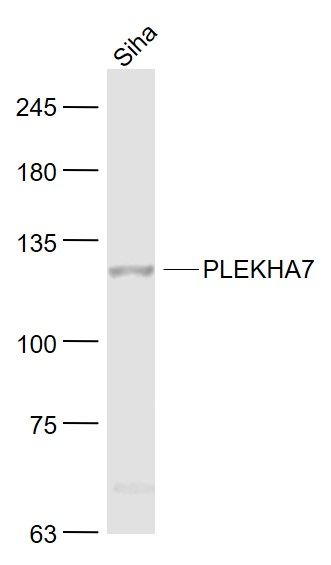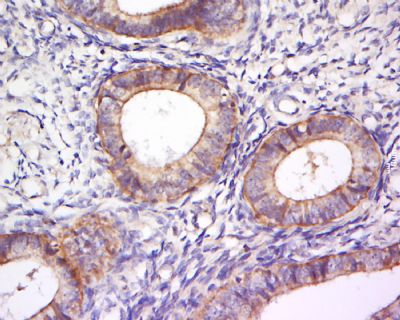PLEKHA7 (pleckstrin homology domain containing, family A member 7), also known as PH domain-containing family A member 7, is a 1,121 amino acid protein that contains one PH domain and two WW domains. Encoded by a gene that maps to human chromosome 11p15.1, PLEKHA7 exists as three alternatively spliced isoforms. Localizing to cell-cell junctions in Caco2 cells, PLEKHA7 interacts with the adherens junction protein p120 in human colon carcinoma cells. PLEKHA7 also colocalizes with zona adherens proteins and is necessary for zonula adherens biogenesis and maintenance. Associated with systolic blood pressure (SBP) and hypertension, PLEKHA7 is a potential target for the prevention or treatment of hypertension. PLEKHA7 is also linked to autoimmune hepatitis type 1, a chronic active hepatitis characterized by hypergammaglobulinemia and autoantibodies.
Function:
Required for zonula adherens biogenesis and maintenance. Acts via its interaction with KIAA1543/Nezha, which anchors microtubules at their minus-ends to zonula adherens, leading to recruit KIFC3 kinesin to junctional site.
Subcellular Location:
Cell junction > adherens junction. Cytoplasm. Cytoplasm > cytoskeleton > centrosome. Localizes to zonula adherens, recruited via its interaction with CTNND1.
Similarity:
Contains 1 PH domain.
Contains 2 WW domains.
SWISS:
Q6IQ23
Gene ID:
144100
Database links:
Entrez Gene: 144100 Human
Omim: 612686 Human
SwissProt: Q6IQ23 Human
Unigene: 12332 Human
| Picture |
Sample:
Siha(Human) Cell Lysate at 30 ug
Primary: Anti- PLEKHA7 (SL13730R) at 1/1000 dilution
Secondary: IRDye800CW Goat Anti-Rabbit IgG at 1/20000 dilution
Predicted band size: 127 kD
Observed band size: 127 kD
Tissue/cell: human cervical cancer; 4% Paraformaldehyde-fixed and paraffin-embedded;
Antigen retrieval: citrate buffer ( 0.01M, pH 6.0 ), Boiling bathing for 15min; Block endogenous peroxidase by 3% Hydrogen peroxide for 30min; Blocking buffer (normal goat serum,SLC0005) at 37℃ for 20 min;
Incubation: Anti-PLEKHA7 Polyclonal Antibody, Unconjugated(SL13730R) 1:500, overnight at 4°C, followed by conjugation to the secondary antibody(SP-0023) and DAB(SLC0010) staining
|
|
|

